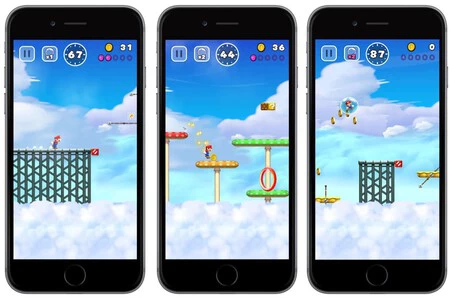When it comes to video games, Nintendo consoles provide endless fun for everyone from simple hardware, while PCs are a display almost inexhaustible of technical possibilities. But there was a time when the NES reigned alone and computer video games didn’t even offer something that today seems so extremely simple as a side scrolling gentle. At least, until the legendary John Romero and John Carmack came along.
Before offering to turn Mars upside down with cannon fire and explosions, the fathers of DOOM brought Super Mario Bros. 3 to PC. A spectacular conversion and a double milestone, in fact, since according to what Romero himself declared in various media or the Netflix High Score documentary, the graphics of the mouse and keyboard systems had not advanced enough to offer smooth side scrolling like in the 8 bits of Nintendo.
“There were Mario-like side-scrolling games that moved in jerky motions, but those jerky movements didn’t feel real and took you away from the game. That was the most you could do to date.”
Which leads us to three more than reasonable questions at this point: what the heck is that side scrolling thing? And how did they manage to bring the experience of Super Mario to PC? And what does all of the above have to do with DOOM?. Let’s start by solving the first unknown.
The magic of side scrolling in the age of 8 and 16 bits
What is side scrolling? Does the vertical exist? Borrowing Anglicism”scroll” (generally used for this term) and oversimplified, we could consider that a side scroll It is the process by which we see the action unfold from one end of the entire stage to the other while the camera follows the action.
The vertical works exactly the same, except that the journey is from top to bottom or vice versa, and the best example of this is found in the classic saga of Super Mario Bros. and how it has evolved delivery to delivery.
It is not that there was no lateral (or vertical) scroll on PC, but rather that it was not fluid as on NES, so that very little concealed transitions were chosen, practically closed areas that gave way to each other or a follow-up of the action pretty clumsy compared to the jumping Mario or those platforming heroes from Nintendo.
And beware, not offering smooth side scrolling didn’t make them bad games or worse; Nor did I want to say that the NES had special technology: the first Mega Man games, The Legend of Zelda or the mythical Metroid (from Nintendo) did not need it to offer timeless classics that continue to fall in love today.
The other reality is that if you wanted a fluid platform game, the two options were arcade machines or video game consoles. And by consoles we basically mean the NES. And it was like that until one night John Carmack decided that it was time that PC gamers also had their own Super Mario.
iD Software’s Super Mario Bros. 3

John Romero, ax in hand, next to a John Carmack brandishing his sword
In essence, iDSoftware the passion for videogames was born between two lovers of Heavy Metal: john romero and john carmack. That, and what we could almost define as the great grandfather of Xbox Game Pass.
In 1989, a 22-year-old John Romero worked for Gamers Edge, a video game subscription service that, given the limitations of the time, worked analogically, sending subscribers a diskette with video games or any type of content. With luck, according to Romero, you could find something worthwhile.
John Carmack shared the same passion, office, drive to make really good games, and the perfect partner in this madness, as Carmack did the concept and graphics while Romero did the programming and design. Does that mean that Carmack didn’t know how to program? When he put his mind to it, he could blow Romero away. And so it happened.
Usually, both of them spent their time in those offices working or hanging out outside of business hours. Listening to Heavy Metal and playing the NES on loop hallucinating with those Nintendo games. Until the inevitable happened: one day Carmack set out to bring the Mario experience to PC. Or, rather, one night, as Romero recounted.
“When I got there the next day at 10am, I had a demo on my desk called ‘Dangerous Dave in breach of copyright’. Dangerous Dave was a game I had made a month before, so I thought… ‘Wow, something. they will have done to him tonight”.
I put it in the computer and ran it. It started with Super Mario Bros. 3, but with the Dangerous Dave character. And he moved across the screen very smoothly. I couldn’t believe that this was a PC. I couldn’t believe I had made it. Nobody had. It was the first time it was done on a PC.”
That turned the PC into a gaming machine, and I said, “This is a big breakthrough. It’s huge. Let’s start a company and make a game.”
The name of that company, by the way, will end up making history: iD Software had just been born. However, that fluidity obtained in the side scrolling was only the foundation on which to build something even greater: an exquisitely fluid gaming experience on PC. Not at the level of video game consoles, but on another scale. Technically, and literally, to a new dimension.
From Nintendo’s platform excellence to the father of first-person shooters
iD Software’s first game came out on May 5, 1992. Sonic was about to celebrate his first year and receive a spectacular sequel on the Mega Drive. Super Mario World had fallen in love with the entire planet after the arrival of SNES in Europe with years of margin compared to Japan and the United States. And on PC?
John Romero and John Carmack brought Nazi kick-ass like never before in a video game: with 70 frames-per-second 3D graphics, cutting-edge digitized sounds, colorful settings, and unrivaled explosive action. The name of the project: Wolfenstein 3D. And it was a mind-blowing commercial success. And after that?
The general plan was relatively ambiguous. Romero and Carmack wanted to offer a more eerie and sinister setting, gameplay with a fluidity never seen before, and something that could already be done in video games but had never been considered well enough to start a revolution: LAN and online multiplayer.
because the internet was in diapers and the online gaming offer was already relatively varied, but far from fluid. And much less exciting.

With a clear vision of what they wanted to offer and relying on the lessons learned from their Super Mario Bros. and wolfensteiniD Software combined the key elements and a healthy dose of Heavy Metal to forge a glorious revolution in gaming: the DOOM original from 1993. In fact, they were so clear that this would be a hit that they announced the video game without having done anything except the name of the game. Something that, by the way, Nintendo has also come to do.
Why the name DOOM? Basically, Romero and Carmack borrowed it from the name of the pool cue used by the character played by Tom Cruise in The Color of Money. And we won’t deny it, “Doom”, which translates as Doom, was a spectacular name in 1993 and it still is 30 years later.
And beware, what DOOM It was not only technologically ahead, in regards to its multiplayer or in its way of offering visceral 3D action, but it even opted for a distribution model that was well ahead of its time: shareware. Which, in essence, consisted of dividing the game into several parts, offering the first one for free and offering the possibility of buying the rest.

Super Mario Run for iOS
A model that will later be standardized and that Nintendo and Super Mario himself will adopt decades later with Super Mario Run. on iOS and Android, offering the first levels for free and giving the possibility of acquiring the complete game through a single payment.
From the outside it might seem that iD Software and Nintendo are two companies with little in common, but the reality is that they have a really fascinating joint history. Perhaps, we were left without seeing that Super Mario Bros. 3 from iD Software on PC (through official channels) but SNES had its own DOOM, an amazing DOOM 64 was created for the N64 and even DOOM Slayer himself found its way into Super Smash Bros.
And we are not going to deny it: despite the fact that Nintendo Switch is a relatively simple console in terms of Hardware, the way in which Bethesdae iD Software took DOOM Eternal is to take our hats off. Although not as much as that time Carmack brought Mario to PCs.
In ExtraLife | Bethesda’s 13 best games, from Wolfenstein 3D to DOOM Eternal
In ExtraLife | DOOM Eternal: Top 17 Essential Tips and Tricks to Pulverize the Armies of Hell (and Live to Tell)

